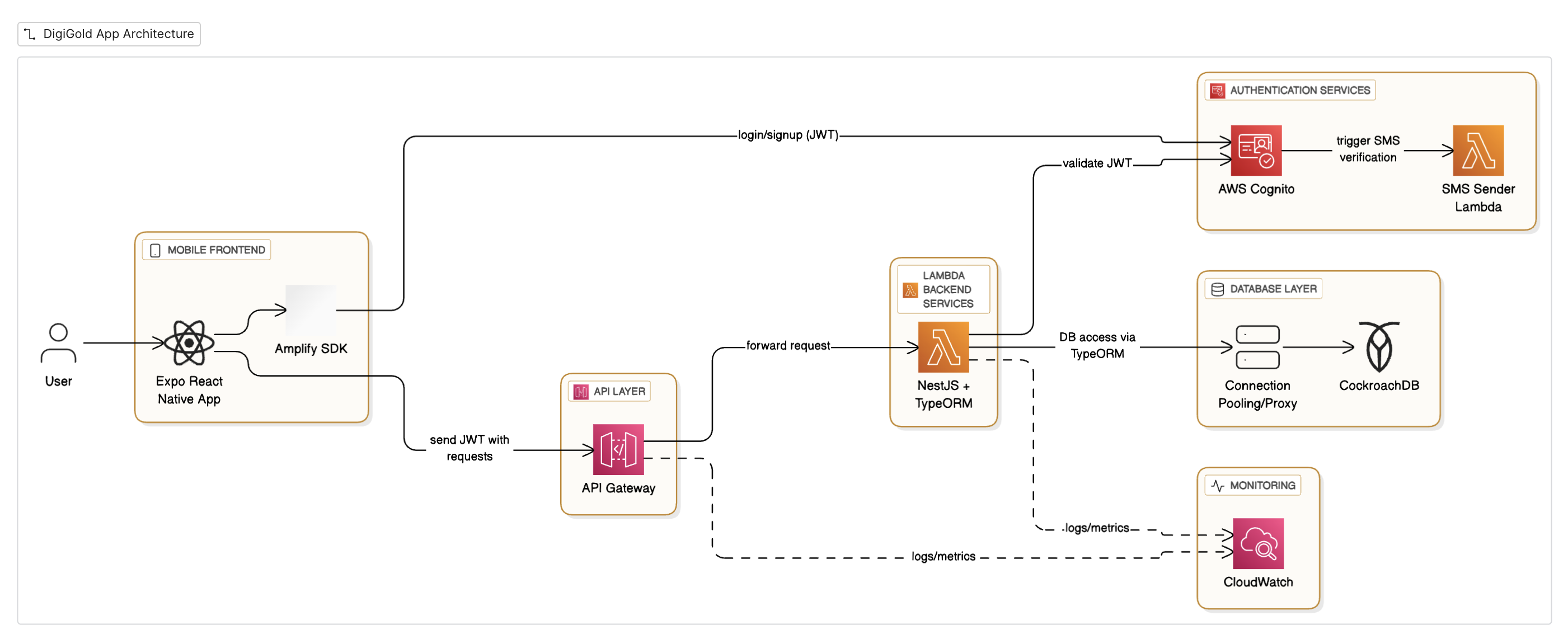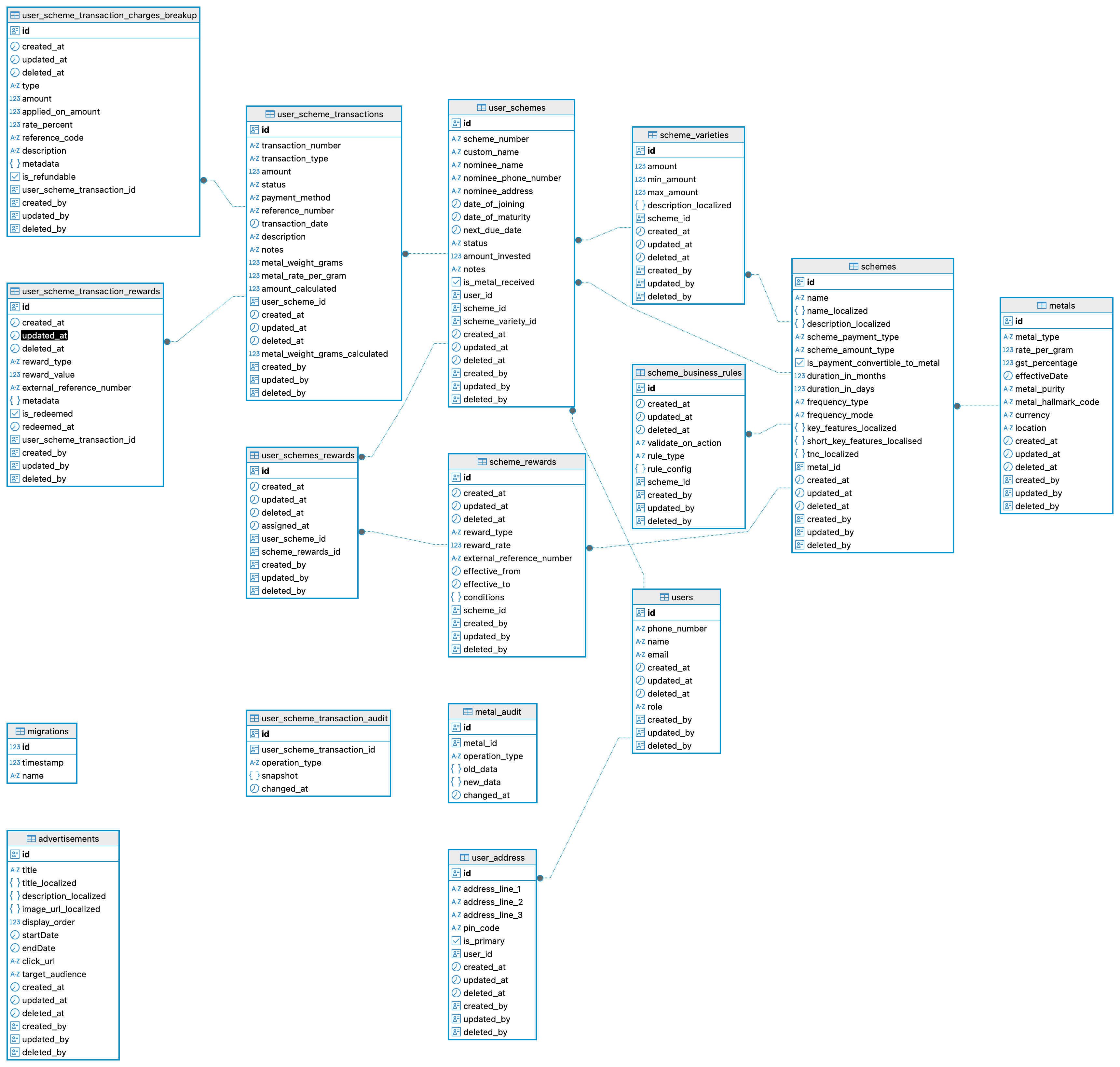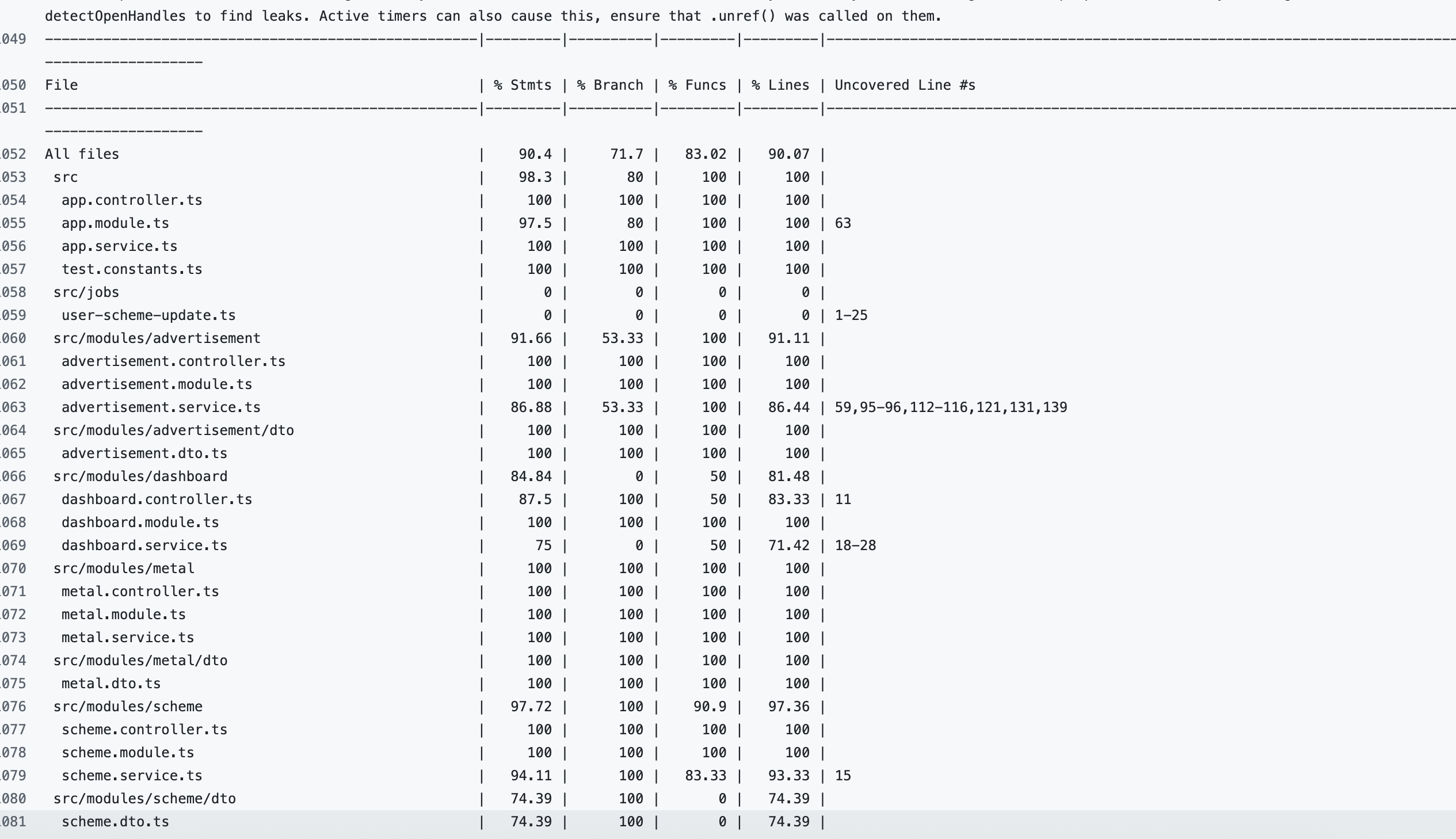💰 DigiGold App
End-to-End Digital Gold Investment Platform
I independently designed, built, and deployed the DigiGold App, handling backend services, React Native Expo mobile app, and infrastructure setup. Below is a detailed breakdown of my tech stack choices with cost and scalability considerations.
💳 Online Payments (In Progress)
Currently, online payment integration is in development. We are in discussions with a payment provider, and approval is pending. Once integrated, all scheme transactions will be seamlessly linked with payment records for full auditability.
☁️ Architecture Diagram

💳 Scheme Domain Design
The DigiGold app supports structured gold saving schemes, designed to handle metals, business rules, rewards, and financial transactions in a scalable way. Below is the conceptual breakdown:
- Metals: Core entity representing the investment asset. Supports Gold and Silver initially, but extendable Platinum, etc. Each metal has attributes such as purity, live price.
- Schemes: Defines user-facing savings plans (Daily, Weekly, Monthly). Includes duration, minimum contribution, and maturity conditions.
- Scheme Business Rules: Encodes plan logic — e.g., Maximum scheme allowed, Scheme transaction window etc..
- Scheme Rewards: Incentives applied on top of schemes, such as bonus gold grams on maturity or discounts on making charges. Configurable per scheme and tied into reward disbursement workflows.
- Scheme Transactions: Records all user contributions and resulting gold allocation (grams purchased at real-time price). Immutable ledger ensuring auditability and reconciliation with payments.

✅ Result: A domain-driven design that ensures DigiGold schemes are flexible, auditable, and extensible for new metals, business rules, and reward models. This structure provides a strong foundation for compliance, customer trust, and growth.
☁️ Serverless vs Server
I chose Serveress over server-based deployments. For ~1000 MAUs, Serverless pay-per-request model ensures cost efficiency, while traditional servers would incur fixed monthly costs even when idle.
☁️ Serverless Compute Choice — AWS Lambda vs Fargate Serverless
For 1,000 MAUs, each using the app ~10 times/month and triggering 5–10 API calls per session, the monthly traffic is 50k–100k API calls. Below is the cost breakdown for AWS Lambda and AWS Fargate Serverless.
- Duration per request: 200 ms
- Lambda memory sizes: 128 MB and 512 MB
- Fargate configs: 0.25 vCPU + 0.5 GB, 0.5 vCPU + 1 GB
| Configuration | AWS Lambda | AWS Fargate Serverless |
|---|---|---|
| 128 MB / 0.25 vCPU + 0.5 GB |
$0 (covered by free tier) 2,500 GB-s, 100k requests < 400k GB-s + 1M requests free |
$0.068 / month
100k × (0.25 vCPU + 0.5 GB × 0.2s) |
| 512 MB / 0.5 vCPU + 1 GB |
$0 (covered by free tier) 10,000 GB-s < 400k GB-s free |
$0.137 / month
100k × (0.5 vCPU + 1 GB × 0.2s) |
✅ At 1,000 MAUs (≤100k API calls/month): Lambda runs entirely free, while Fargate Serverless costs just a few cents.
✅ Scaling beyond free tier: Lambda costs grow per request + GB-s, while Fargate Serverless charges per vCPU-second + GB-second (predictable for heavier workloads).
✅ Why Lambda here? Zero cost at current scale, automatic scaling, minimal ops overhead.
🗄️ Database Choice — CockroachDB Serverless vs Aurora Serverless v2
For database, I compared CockroachDB (serverless, distributed SQL) with Aurora. With 50M free Request Units (RUs) on CockroachDB, small-to-medium scale workloads fit entirely in free tier.
For 1,000 MAUs (~100k API calls/month), each request consumes ~ 2 Request Units (RUs). That’s ~ 200k RUs/month, plus ~ 5 GB storage for user & transaction data.
- Workload: 70% reads, 30% writes
- RU consumption: ~2 RUs per API call → 100k × 2 = 200k RUs
- Storage baseline: ~5 GB
| Configuration | CockroachDB Serverless | Aurora Serverless v2 |
|---|---|---|
| Compute / RUs |
200k RUs < 50M free
$0 (well under free quota) |
Billed in ACUs (~$0.06/ACU-hour) For 0.5–1 ACU baseline = ~ $21–$43/month |
| Storage (5 GB) | $0 (10 GB free storage) | ~$0.10/GB = $0.50/month |
| Scaling | Auto-scales RUs within quota Generous free tier for early stage |
Auto-scales ACUs in fine-grained steps Better for heavier workloads |
✅ At 1,000 MAUs: CockroachDB Serverless runs entirely free (200k RUs ≪ 50M free, 5 GB ≪ 10 GB free).
✅ Aurora Serverless v2: Always-on baseline capacity (~0.5–1 ACU) costs ~$20–40/month, even at low traffic.
✅ Why CockroachDB here? Zero cost at current scale, built-in HA, and no upfront compute billing. Aurora shines at higher scale with enterprise-grade AWS ecosystem integration.
🔐 Cognito + Custom SMS Sender
For the DigiGold app, I implemented AWS Cognito with a Custom SMS Sender to deliver OTPs and MFA codes through an existing business SMS provider, ensuring better deliverability, branding, and cost efficiency.
- Authentication: Cognito generates and validates OTPs securely.
- Custom SMS Flow: Lambda decrypts codes (AWS Encryption SDK + KMS) and sends via provider API.
- Secrets Management: Provider credentials stored in AWS Secrets Manager.
- Operational Benefits: Full control of sender IDs, delivery receipts, and compliance with regional SMS rules.
- Scalability: Lambda auto-scales with demand; no infrastructure to manage.
💰 Cost Breakdown @ 1,000 MAUs
- AWS KMS: ~$1 / month (for encryption key usage)
- SMS Delivery: ~10,00 OTPs × ₹0.15 = ~₹150 / month (~$2)
- Total: ~₹230 / month (~$3)
✅ Result: Seamless multi-factor authentication with secure, branded SMS delivery, leveraging Cognito’s security while keeping costs predictable with the existing SMS provider.
⚙️ Backend Framework & Data Layer
For the DigiGold app, I built the backend using NestJS with Fastify as the HTTP adapter, and TypeORM for the data access layer. This combination provided high performance, scalability, and a clean developer experience.
| Aspect | NestJS + Fastify | NestJS + Express |
|---|---|---|
| Performance | 🚀 2x faster request handling Lower latency under concurrent load |
Standard performance Slower under high concurrency |
| Resource Usage | Lightweight, better memory efficiency Ideal for serverless/Lambda |
Higher memory footprint More overhead for small instances |
| Ecosystem | Compatible with NestJS decorators, DI, and middleware Fully supported |
Mature ecosystem, large community Well-known in industry |
| TypeORM Integration | First-class support Works seamlessly with Postgres, CockroachDB, Aurora |
Same ORM support But slightly more overhead per query |
📊 Data Layer (TypeORM)
- Unified ORM layer with Postgres-compatible DBs (CockroachDB, Aurora).
- Entity-driven design with migrations and schema sync.
- Optimized queries to stay within free RU limits for CockroachDB.
📱 Mobile App (React Native Expo)
- Expo for rapid development, OTA updates, and smaller team velocity.
- Integrated with backend APIs via Axios/GraphQL (secured with Cognito JWT).
- Firebase Crashlytics & Analytics for app monitoring and user insights.
- Firebase Cloud Messaging for push notifications.
✅ Result: A backend optimized for serverless performance and low cost, paired with a cross-platform mobile app (iOS + Android) for a seamless DigiGold user experience.
☁️ Lambda with TypeORM vs Plain JavaScript Functions
While simple JavaScript functions could directly query the database inside AWS Lambda, I chose TypeORM with NestJS for DigiGold. This decision provided strong consistency, maintainability, and scalability for a financial-grade application.
| Aspect | Lambda + TypeORM | Lambda + Plain JS Functions |
|---|---|---|
| Code Organization | ✅ Entity-driven models, repositories ✅ Reusable services, clean architecture |
❌ Ad-hoc SQL strings ❌ Harder to maintain and scale |
| Database Portability | ✅ Works seamlessly with Postgres, CockroachDB, Aurora ✅ Easy migration scripts |
❌ Vendor lock-in (raw queries) ❌ No migration tooling |
| Security & Validation | ✅ Automatic query sanitization ✅ Strong typing with entities |
❌ Risk of SQL injection ❌ Manual validation required |
| Maintainability | ✅ Standardized patterns ✅ Onboarding-friendly for teams |
❌ Logic scattered in functions ❌ Harder to debug complex flows |
| Performance in Lambda | ⚡ Slightly higher cold start due to ORM init But optimized with connection pooling + Fastify |
⚡ Lower cold start overhead But higher dev/ops cost in the long run |
✅ Why TypeORM? Even though plain JS functions are lighter, TypeORM ensures long-term scalability, security, and developer productivity — all critical for a financial app like DigiGold, where data integrity and maintainability matter more than a few milliseconds of cold-start latency.
📱 React Native Expo vs Plain React Native CLI
For the DigiGold mobile app, I chose React Native with Expo over plain React Native CLI to accelerate development, streamline deployment, and ensure consistent cross-platform behavior.
| Aspect | React Native + Expo | Plain React Native CLI |
|---|---|---|
| Setup & Development Speed | ✅ Simplified setup ✅ Pre-configured tooling, OTA updates via Expo ✅ Fast iteration with Expo Go app |
❌ Manual configuration for iOS/Android ❌ Slower iteration without Expo tools |
| Cross-Platform Consistency | ✅ Single build system for iOS & Android ✅ Handles native dependencies internally |
❌ Separate native project management required ❌ More risk of platform-specific bugs |
| Build & Deployment | ✅ OTA updates without app store resubmission ✅ EAS Build supports staging & production builds |
❌ Requires Xcode/Android Studio for every build ❌ OTA updates require custom infrastructure |
| Performance & Flexibility | ⚡ Slightly larger binary and minor performance overhead for managed workflow ⚡ Can eject if full native control is needed |
⚡ Leaner binaries ⚡ Full native control by default |
✅ Why Expo? Chose Expo for faster development, OTA updates, cross-platform consistency, and simplified integration with backend (Cognito + TypeORM) and analytics tools (Firebase). Ejected only when deeper native control was required.
🔐 Monitoring, Engagement & CI/CD
- Firebase Crashlytics → Real-time error reporting for React Native app
- Firebase Analytics → User behavior insights and engagement tracking
- Firebase Cloud Messaging → Push notifications for user engagement
- AWS CloudWatch → Logs, metrics, and alerts for backend (Lambda, Fastify + NestJS)
- CI/CD with GitHub Actions → Automated build, test, and deployment pipelines for both backend and mobile app (staging & production)
✅ Result: Full-stack monitoring with real-time alerts, actionable analytics, and automated deployment pipelines for faster iteration and reliable production releases.
🧪 Integration Testing & Code Coverage
To ensure the DigiGold app is reliable and production-ready, I built a strong integration testing suite covering backend services, authentication flows, and database interactions.
- Automated tests written in Jest within the NestJS framework.
- Covered end-to-end flows: user onboarding → authentication → gold schemes → gold transactions.
- CI/CD integration: GitHub Actions runs all tests on every commit/pull request before deployment.
- Achieved Test Parallism with test containers, and making sure every tests run isolated.
- Achieved 90%+ coverage, aiming for 99%+ full coverage.

Current coverage: 90%+ (Target: 99%+)
✅ Result: Reliable deployments with confidence in backend correctness, reducing production issues and ensuring financial-grade stability.